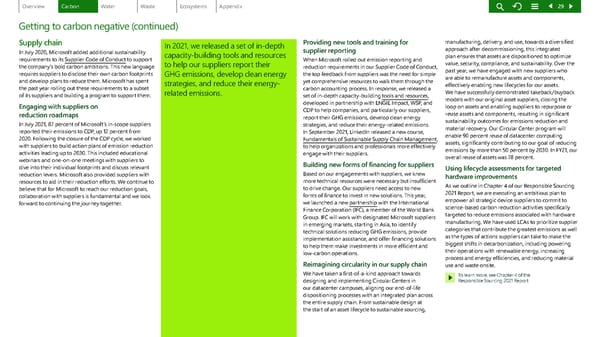Getting to carbon negative (continued) Supply chain In July 2020, Microsoft added additional sustainability requirement s to its Supplier Code of Conduct to support the com pany’s bold carbon ambitions. This new language requires suppliers to disclose their own carbon footprints and develop plans to reduce them. Microsoft has spent the past year rolling out these requirements to a subset of its suppliers and building a program to support them. Engaging with suppliers on reduction roadmaps In July 2021, 87 percent of Microsoft’s in-scope suppliers reported thei r emissions to CDP, up 12 percent from 2020. Following the closure of the CDP cycle, we worked with suppliers to build action plans of emission reduction activities leading up to 2030. This included educational webinars and one-on-one meetings with suppliers to dive into their individual footprints and discuss relevant reduction levers. Microsoft also provided suppliers with resources to aid in their reduction efforts. We continue to believe that for Microsoft to reach our reduction goals, collaboration with suppliers is fundamental and we look forward to continuing the journey together. In 2021, we released a set of in-depth capacity-building tools and resources to help our suppliers report their GHG emissions, develop clean energy strategies, and reduce their energy- related emissions. Providing new tools and training for supplier reporting When Microsoft rolled out emission reporting and reduction requirements in our Supplier Code of Conduct, the top feedback from suppliers was the need for simple yet comprehensive resources to walk them through the carbon accounting process. In response, we released a set of in-depth capacity-building tools and reso urces , developed in pa rtnership with ENGIE Impact, WSP, and CDP to help companies, and particularly our suppliers, report their GHG emissions, develop clean energy strategies, and reduce their energy-related emissions. In September 2021, LinkedIn released a new course, Fundamental s of Sustainable Supply Chain Management , to help organi zations and professionals more effectively engage with their suppliers. Building new forms of financing for suppliers Based on our engagements with suppliers, we knew more technica l resources were necessary but insufficient to drive change . Our suppliers need access to new forms of finance t o invest in new solutions. This year, we launched a new partnershi p with the Inter national Finance Corporation (IFC), a member of the World Bank Group. IFC will work with designated Microsoft suppliers in emerging markets, starting in Asia, to identify technical solutions reducing GHG emissions, provide implementat ion assistance, and offer financing solutions to help them make investments in more efficient and low-carbon oper ations. Reimagining circularity in our supply chain We have taken a first-of-a-kind approach towards designing and implementing Circular Centers in our datacenter campuses, aligning our end-of-life dispositioning processes with an integrated plan across the entire supply chain. From sustainable design at the start of an asset lifecycle to sustainable sourcing, manufacturing, delivery, and use, towards a diversified approach after decommissioning, this integrated plan ensures that assets are dispositioned to optimize value, security, compliance, and sustainability. Over the past year, we have engaged with new suppliers who are able to remanufacture assets and components, effectively enabling new lifecycles for our assets. We have successfully demonstrated takeback/buyback models with our original asset suppliers, closing the loop on assets and enabling suppliers to repurpose or reuse assets and components, resulting in significant sustainability outcomes for emissions reduction and material recovery. Our Circular Center program will enable 90 percent reuse of datacenter computing assets, significantly contributing to our goal of reducing emissions by more than 50 percent by 2030. In FY21, our overall reuse of assets was 78 percent. Using lifecycle assessments for targeted hardware improvements As we outline in Chapter 4 of our Responsible Sourcing 2021 Report, we are executing an ambitious plan to empower all strategic device suppliers to commit to science-based carbon reduction activities specifically targeted to reduce emissions associated with hardware manufacturing. We have used LCAs to prioritize supplier categories that contribute the greatest emissions as well as the types of actions suppliers can take to make the biggest shifts in decarbonization, including powering their operations with renewable energy, increasing process and energy efficiencies, and reducing material use and waste onsite. To learn more, see Chapter 4 of the Responsible Sourcing 2021 Report 29
 Environmental Sustainability Report | Microsoft Page 28 Page 30
Environmental Sustainability Report | Microsoft Page 28 Page 30